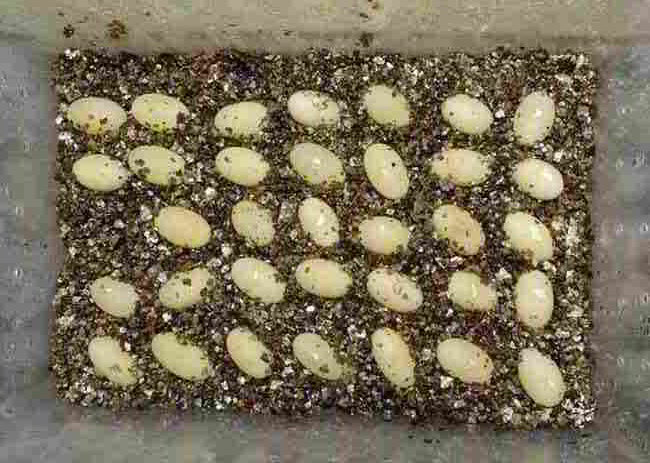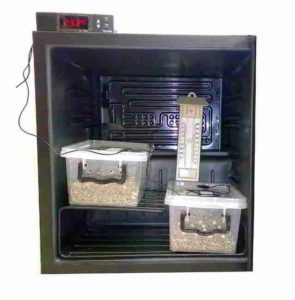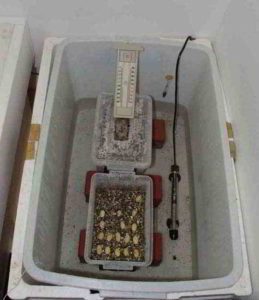Chameleon egg incubation
Chameleon egg incubation is fairly easy so long as the various conditions for each species are taken into account. There are big temperature differences between species, for example, Veiled chameleon eggs should be incubated at 26°c whereas Panther chameleon eggs need about 24°c.
Chameleon egg incubation for some species, such as Carpet chameleons, involves a diapause of one month at between 10 to 15°c and then incubation at 24°c. Others, such as Fischer’s, will require low temperatures of around 18°c for most of the incubation period, with a final month at 24°c.

Keeping the temperature higher will not speed up the chameleon egg incubation process. Quite the reverse – higher temperatures will often slow down the process. Panther chameleon egg incubation could take an extra 3 to 6 months if kept at 26°c, or even fail to hatch completely.
In only a few cases should the eggs be left where they are laid. These would include eggs laid by Brookesias and Rhampholeons, which I have hatched by just leaving the eggs in situ. The risk is you have no control over humidity or the damage caused by small insects. However, with eggs as small as these finding them is the biggest problem!
Moving the eggs

Eggs to be incubated should be dug up carefully and not rotated. I place them in plastic containers, e.g. 5 litre ice cream tubs, with holes drilled all along the sides to allow for air circulation. The bottom of the container is filled with damp vermiculite to a depth of about 3cm. The eggs are carefully placed in the vermiculite so that about two-thirds of the egg is showing.
There are various ways to incubate the eggs. Much depends on the species and your situation. You can buy incubators designed for hatching reptile eggs. Read the reviews carefully as some have a reputation for not controlling the temperature accurately. For my Fischer’s chameleons, I used a small wine cooler with an external thermostat.
Bain Marie Incubator

In South Africa, I used what is known as a Bain Marie incubator, which is easy to make. I used an 80 litre plastic storage box with some bricks in the bottom. Water was poured in until it was level with the bricks. An ordinary aquarium heater was secured to the bottom of the box and set to the required temperature. Boxes containing the eggs were laid on top of the bricks.
It is important to ensure that the water level does not drop too low or else the heater might crack. As there is water and electricity in close proximity you might want to use a qualified electrician to check the wiring.
The Bain Marie is useful when temperatures are typically below those needed for incubation. The water will hold the heat and even out spikes in temperature caused by the thermostat. It also maintains a steady humid atmosphere. I enjoyed a near 100% hatch rate from all eggs using the Bain Marie system.
Chameleon egg incubation using a Dry Incubator
Incubating eggs in Malaysia presented a different problem. With an ambient temperature of 28°c indoors and much higher outside, here the issue is keeping the eggs cool enough. To my wife’s dismay, this meant keeping the eggs in an 80 litre plastic storage box in the spare bedroom.
The room is kept at a fairly constant 26°c by using the air-con and no water is needed as the atmosphere is damp anyway. I relied heavily on individual hygrometers in each box of eggs to let me know when the vermiculite was drying slightly and added water when needed.
Despite the air-con, the temperature fluctuated more than I would have liked between 23°c and 29°c. This had no obvious ill-effect on the eggs, although the hatch rate was slightly lower than in South Africa at about 95%.
Hatching
Chameleon egg hatching can be frustrating. Not all chameleons will hatch at the same time. Typically, all of the Veiled chameleon eggs in a single batch of eggs will hatch within a week of each other, often within two days. Panther chameleon eggs may take up to 2 months for a single batch of eggs to completely hatch, so don’t throw eggs away if they seem to lag behind unless you are sure they are a dud.
Temperatures seem to have little effect on the sex determination of the chameleons. In many reptiles, the sex is, to an extent, controlled by incubation temperature. However, studies of Veiled chameleons have not found this to be the case. Whether other species are affected remains to be seen.
